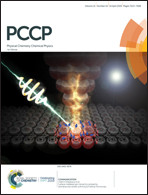Electronic transport properties and magnetoresistance in the Fe3O4/SiO2/p-Si heterostructure with an in-plane current geometry†
Abstract
In traditional electronic devices, the electronic charge is manipulated to realize different functions. The fascinating control of electronic spin in conventional semiconductors increases the probability of occurrence of spin-dependent transport properties. Herein, the injection of electronic spin into a Si wafer with in-plane geometry was achieved by Fe3O4, which acted as a spin injector. At high temperatures, the resistivity of Fe3O4 is far less than that of a p-Si wafer. Moreover, above 190 K, the current–voltage (I–V) characteristic and magnetoresistance (MR) of the proposed heterostructure are dominated by the intrinsic properties of a polycrystalline Fe3O4 film, and the in-plane current flows in the Fe3O4 layer. Due to the increased resistivity of Fe3O4 at low temperatures, the in-plane conductive channel gradually switches from Fe3O4 to Si. The spin injection from Fe3O4 results in a spin-polarized space charge region in p-Si. The heterostructure shows an MR of up to −76.1% at 90 K due to the spin-dependent transport of electrons in p-Si. With a further decrease in temperature, the I–V characteristic of the heterostructure shows negative differential resistance below 80 K due to band bending at the Fe3O4/SiO2/p-Si interface.



 Please wait while we load your content...
Please wait while we load your content...